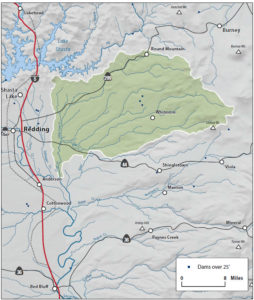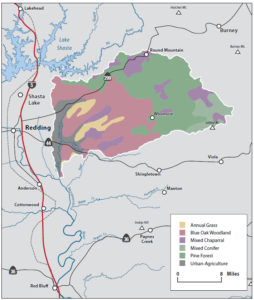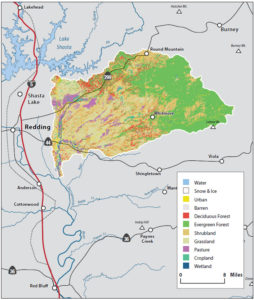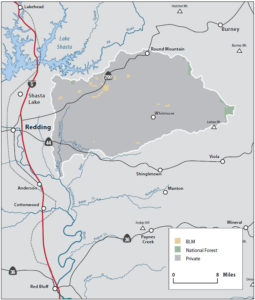Lower Cow Creek near the town of Palo Cedro
The Watershed at a Glance
The 275,000-acre Cow Creek Watershed (about the size of the state of Delaware) is a large, generally uncontrolled tributary to the Sacramento River located in eastern Shasta County. The watershed is unique in that land ownership is divided almost evenly among commercial forestland, commercial agriculture (predominantly cattle ranching), and small private residential properties, with minimal public ownership. The watershed includes five principal tributaries: North Fork Cow, Oak Run, Clover, Old Cow, and South Fork Cow Creeks. It provides important habitat for fall-run and late fall-run Chinook salmon and steelhead. There are no major reservoirs, but numerous small dams divert water for irrigation and hydropower production. Management program efforts have focused on providing passage for anadromous fish, reducing risk of wildfire, and addressing concerns with seasonal low flow, temperature, and bacteria levels.
Hydrology
From 1949 until the present, USGS has maintained daily flow records for Cow Creek at a gauge located just upstream of the confluence with the Sacramento River. Average annual flow during this period of record is 695 cfs. The maximum peak flow was 48,700 cfs in November 1981 with a minimum of near 0 cfs in July 1997. Cow Creek ranks third behind Cottonwood Creek and Stony Creek for producing the largest peak floodflows in the northern Sacramento Valley. It has been estimated that floodflows from the Cow Creek Watershed account for approximately 21% of the peak discharge for the Sacramento River between Shasta Dam and Red Bluff. Water rights in the Cow Creek Watershed are adjudicated (established by court decree), and there are approximately 278 recorded points of diversion. Water use is mostly for pasture irrigation, stock water, and hydropower (PG&E is in the process of decommissioning their Cow Creek hydropower facilities). These diversions significantly affect instream flow in the lower reaches of Cow Creek during the summer season.
Water Quality
Both the Central Valley RWQCB and the Cow Creek Watershed Management Group have conducted monitoring in recent years. The primary water quality issues in the watershed relate to bacteria, temperature, and erosion/sediment discharge. There is one inactive, abandoned copper mine (Afterthought Mine); however, acid and metals draining from this site appear to have only localized impacts in North Fork Cow Creek. E. coli levels are a concern, given the extensive contact recreation use in this stream (swimming and tubing), and North Fork Cow, Clover, Oak Run, and South Fork Cow Creeks are all 303(d) listed as impaired waterbodies for bacteria. Likely sources include domestic livestock, faulty septic systems, and wildlife. Temperature is an important factor in successful spawning and rearing of salmon and steelhead and in some years may be a problem seasonally for in-migration of adults (October and November) and out-migration of juveniles (April, May, and June).
Vegetation
The Cow Creek Watershed has diverse plant communities resulting from its varying topography, soils, and elevation change that ranges from 400 feet on the valley floor to above 7,000 feet in the forested uplands. Native plant communities are:
- riparian forest (1%);
- wetlands (marshes, vernal pools, and wet meadows) (1%);
- annual grasslands (4%);
- blue oak and foothill pine woodlands (48%);
- chaparral (1%); and
- coniferous forest (45%).
Native plant communities in the watershed have been altered significantly by aggressive fire suppression, conversion for agriculture, and the introduction of invasive species (e.g., Himalayan blackberry, yellow star-thistle, Pampas grass). Historically, coniferous forests were open and park-like, whereas today’s forests are dominated by dense, small-diameter, shade-tolerant trees with thick understory. This condition results in significant fuel loading and high fire danger.
Fish and Wildlife
Three different groups of fish live in Cow Creek: anadromous, resident, and exotic. Anadromous species that migrate up the watershed to locations downstream of natural barriers include fall-run Chinook salmon and winter-run steelhead. Common resident species are rainbow trout (generally above 1,000 feet elevation), hardhead, pikeminnow, and sculpin. Exotic species known to occur in Cow Creek are large-mouth and smallmouth bass, carp, bluegill, brown trout, and brook trout. Fishery agencies have estimated that 9,000 female salmon potentially could use the 66 miles of Cow Creek streambed. Recent counts have been far below that potential, ranging from a few thousand to only a few hundred in the last couple of years. Cow Creek is a high-priority watershed in the basin-wide effort to increase anadromous fish populations, and restoration efforts will target concerns with instream flow, passage and screening of diversions, water temperature conditions, and habitat improvements.
Cow Creek supports a large population of blacktail deer, but that herd is known to be in decline partly because of a reduction in early plant succession habitat (a principal food source for deer). Turkeys, bear, mountain lion, feral pigs, and more recently elk, are all well established in the watershed.
Life in the Watershed
Privately held lands dominate the watershed. At just over 30% of the land base, timber production is a significant commercial activity (major landowners include Roseburg Resources Company, Beaty and Associates, and Sierra Pacific Industries). Ranching and livestock production are a major agricultural component contributing to the rural character and country lifestyle so valued by residents of this watershed. The Williamson Act, which offers tax incentives for preservation of agricultural lands, is an important mechanism in maintaining the rural lifestyle, and currently about 75,000 acres in the Cow Creek Watershed are enrolled in that program. Residential development is centered around the small communities of Palo Cedro, Bella Vista, Millville, Oak Run, and Whitmore. Outdoor activities such as camping, fishing, hunting, and ORV use are important pastimes for most residents and also significantly contribute to the local economy. The Latour State Forest is the largest public ownership in the watershed.
Management Objectives
The CCWMG, together with the Western Shasta RCD, completed the Cow Creek Watershed Assessment in November 2001 and the Cow Creek Watershed Management Plan in March 2005. As discussed in these reports, the principal issues and management objectives for this watershed are:
- improve water quality by assisting with projects that implement improved management practices,
- improve water quantity by assisting with projects that enhance dry season instream flow,
- increase salmon and steelhead populations by implementing projects that improve aquatic habitat and provide safe passage for migrating fish,
- reduce forest fuel loading and the risk of catastrophic wildfire, and
- promote watershed stewardship through an active education and outreach program.
Management Organizations Active in the Watershed
Cow Creek Watershed Management Group
In response to concerns over water quality, fisheries, habitat loss, and wildfire threat, the Cow Creek Watershed Management Group was formed in 2000 as a nonprofit 501(c)(3) organization with the mission of “using the resources in the Cow Creek Watershed in a way that meets the needs of today without infringing on the needs of future generations.” Western Shasta RCD provides administrative assistance and staff support to the organization. Grant funding was obtained to complete a watershed assessment and management plan, and in the past several years grant-funded projects have been implemented that include fish passage and screens on water diversions, strategic fuel breaks along transportation corridors, and improvements on irrigation canals for the purpose of increasing water use efficiency.





